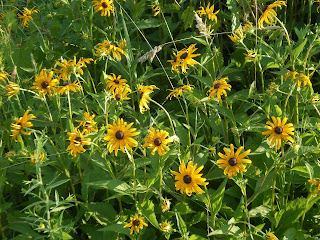The weather has finally cooled down again with much needed rains pushed by the fronts. I've noticed that we have not had very many butterflies this year. When going back through my pictures and daily notes, I've only found a handful this year as compared to previous years.
Swallowtails live for about a year. Once the caterpillar has filled her belly one last time, she finds a quiet spot to make her winter chrysalis. This will keep the swallowtail safe until she emerges in the Spring. Monarchs, on the other hand, can go through as many as three generations before the fourth generation is born to migrate. Although we have a great deal of milkweed growing in our western pasture, I have not seen any Monarchs this year. I suspect the combination of the late frost in May and the never ending rains, may have taken on toll on everyone.
Late July is when the fields of black eyed susans come to bloom. Later these nodding seed heads will feed many birds such as cardinals and waxwings. These seeds are also a favorite to the field mice and chipmunks which provide food for hawks, owls, and foxes. Being aware of the interconnectedness of things doesn't diminish the appreciation of how pretty these flowers are.
Although most of the garlic scrapes were trimmed earlier in the season, this one was left and allowed to bloom. Looks rather other worldly doesn't it?
I love hydrangias. I'm hoping that I can make a trade with one of my neighbors. Perhaps some fresh lovely green beans for a few cuttings of his hydrangia? We'll see.
Late July is when the fields of black eyed susans come to bloom. Later these nodding seed heads will feed many birds such as cardinals and waxwings. These seeds are also a favorite to the field mice and chipmunks which provide food for hawks, owls, and foxes. Being aware of the interconnectedness of things doesn't diminish the appreciation of how pretty these flowers are.
Although most of the garlic scrapes were trimmed earlier in the season, this one was left and allowed to bloom. Looks rather other worldly doesn't it?































